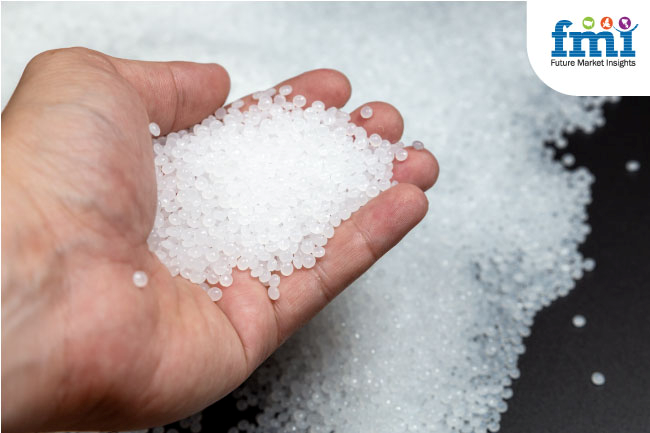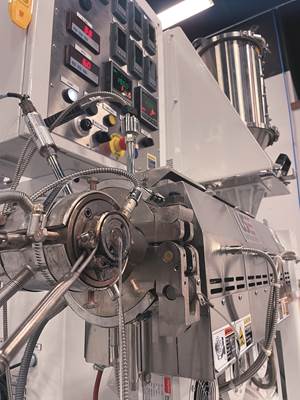Plastic Compounding Market to Outpace Metal & Alloy Market Growth
Study shows the plastic compounding process is being used to boost electrical properties and UV resistance while custom compounding is increasingly being used to achieve high-performance in plastic-based goods.

The global plastic compounding market is set to witness an impressive growth rate of 7.4% from 2022 to 2032, while the market size is anticipated to reach a valuation of about $163.9 billion from its current valuation of $64.8 billion. This according to Plastic Compounding Market to Overshadow the Metal and Alloy Market in Coming Days, a new report from London-based Future Market Insights, a provider of market intelligence and consulting services, serving clients in over 150 countries, with delivery centers in the U.S. and India. Other key takeaways:
▪ The plastic compounding industry is anticipated to grow significantly as metals, natural rubber, wood, glass, and concrete are increasingly replaced by plastic.
▪ Based on various product forms, polypropylene compound is the highest-grossing sector of the target market, with an estimated total share of 25% in 2022.
▪ The most common application of plastic compounding is automotive components, which reportedly held 20% of market share in 2022, and where plastics are increasingly outpacing use of metals and alloys.
▪ The Asia Pacific region was indicated as the dominant region for plastics compounding in 2022, with a market share of over 40%.
According to the study, among current trends poised to propel plastic compounding growth by 2032 are the growing market for biopolymers, novel retail goods packaging methods, and uses for 3D printing or manufacturing techniques. Plastic usage in transportation components is expected to increase significantly over the projected timeframe due to rising sales of personal and commercial vehicles. These developments are anticipated to drive the demand for plastic compounding in the future.
In addition to automotive and aircraft, luxury items, consumer electrical & electronics equipment, construction, and medical are a few of the end-user industries that are to significantly boost the worldwide plastic compounding market trends. Consumption of thermoplastics is anticipated to grow at a rapid rate over the forecasted period.
Meanwhile, demand for products made from biobased materials has increased due to both environmental issues related to hydrocarbon-based plastics and the global depletion of crude oil supplies. The report notes that anticipated government limits on the use of petrochemical-based plastics in many end-use sectors would further encourage the plastic compounding market future trends for the production of biobased polymers.
When compared to their petroleum-based rivals, plastic compounds generated from biobased materials such as PLA (polylactic acid), PHA (polyhydroxyalanote) and PBS (polybutylene succinate) exhibit outstanding biocompatibility. Goods made from these compounds are frequently used for agricultural and medicinal purposes and are significantly supplementing the plastic compounding market key trends.
The report also projects that continuous advancements in catalysis techniques, aimed at improving the performance, adaptability, and production of polyethylene resins, are expected to present profitable prospects for the global plastic compounding market growth in several end-use applications. A crucial component in the packaging sector, PE resins have augmented plastic compounding market opportunities with the rise of e-commerce platforms and online retail businesses. Numerous sectors, including automotive, building, electrical and electronics, and packaging, employ PE compounds extensively. With a sizable market share, the construction sector is the primary end-use vertical for the PE compounds category.
In 2022, the top spot in plastics compounding was held by the polypropylene segment, with PP compounds accounting for over 25% of the market. Touted for their high fracture toughness and processability, PP compounds are widely used in the vehicle sector and are anticipated to see the highest growth in Asia, the Middle East, and Latin America. As noted previously, the Asia Pacific region let the plastic compounding market in 2022 by over 40% of market share.
But, North America is the second largest region for plastic compounding. In both the U.S. and Canada, substantial construction sector growth is anticipated to boost the adoption of plastic compounding throughout the projected period. The infrastructure sector is anticipated to benefit from government rules that assist the revival of the housing industry.
Throughout the forecast period, the U.S. plastic compounding market is likely to benefit along with reconstruction efforts in the U.S. and adjoining countries. Furthermore, recent trade restrictions over aluminum and steel imports from China have provided the necessary impetus for the plastic compounding market growth in the country.
The new report noted that while start-up companies are investing heavily in the biobased product segment, the key market players in global plastic compounding include: BASF, LyondellBasell, Dow, Covestro, Asahi Kasei, Aurora Plastics, Washington Penn, Kuraray, Teijin Ltd., Evonik, and Dyneon. Meanwhile, OEMs, which often enter into strategic relationships with plastic compounding market major players, have emerged to be the major market drivers.
Related Content
Catheter Specialist Finds Sweet Spot Serving Small, Medium-Sized Concerns
Medical-component specialist LightningCath has carved a niche meeting the needs of small to medium-sized entrepreneurs with complex catheter designs … quickly.
Read MoreKrones Acquires Netstal
Krones adds PET preform injection molding to its bottle blowing and filling capabilities, as well as cap molding and expansion into medical, food and other markets.
Read MoreUse Cavity Pressure Measurement to Simplify GMP-Compliant Medical Molding
Cavity-pressure monitoring describes precisely what’s taking place inside the mold, providing a transparent view of the conditions under which a part is created and ensuring conformance with GMP and ISO 13485 in medical injection molding.
Read MoreWisconsin Firms Unite in Battle Against Covid
Teel Plastics opened new plant in record time, partnering with AEC & Aqua Poly Equipment Co. to expand production of swab sticks to fight pandemic.
Read MoreRead Next
Understanding Melting in Single-Screw Extruders
You can better visualize the melting process by “flipping” the observation point so that the barrel appears to be turning clockwise around a stationary screw.
Read MoreLead the Conversation, Change the Conversation
Coverage of single-use plastics can be both misleading and demoralizing. Here are 10 tips for changing the perception of the plastics industry at your company and in your community.
Read MoreWhy (and What) You Need to Dry
Other than polyolefins, almost every other polymer exhibits some level of polarity and therefore can absorb a certain amount of moisture from the atmosphere. Here’s a look at some of these materials, and what needs to be done to dry them.
Read More










.png;maxWidth=300;quality=90)















